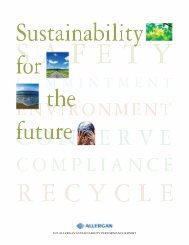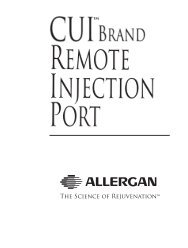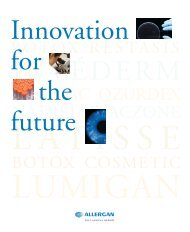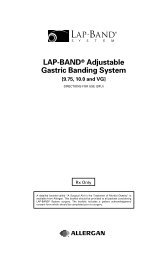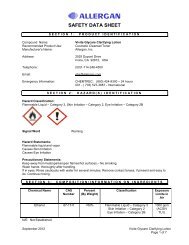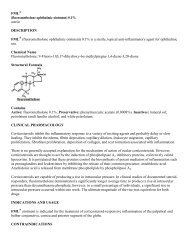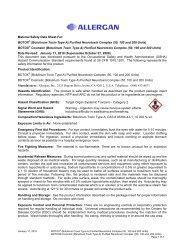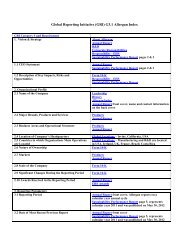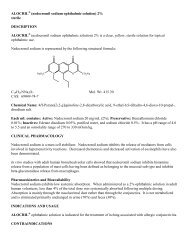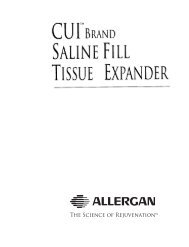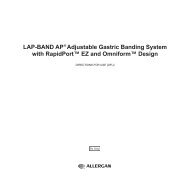JUVÉDERM ® Ultra XC Directions for Use (PDF) - Allergan
JUVÉDERM ® Ultra XC Directions for Use (PDF) - Allergan
JUVÉDERM ® Ultra XC Directions for Use (PDF) - Allergan
Create successful ePaper yourself
Turn your PDF publications into a flip-book with our unique Google optimized e-Paper software.
Injection-SiteResponsesDuration c 1-3DaysRedness2261%Pain1542%Tenderness1439%Firmness1542%Swelling1953%Lumps/Bumps1028%Bruising1233%Itching822%Discoloration1336%Table 2. Duration of Injection-Site Responses(Number/% of Subject NLFs)<strong>JUVÉDERM</strong> <strong>®</strong> <strong>Ultra</strong> <strong>XC</strong>(N a = 36 NLFs)n b %4-7 8-14Days Days4 111% 3%0 10% 3%3 38% 8%7 519% 14%7 219% 6%4 211% 6%8 422% 11%3 08% 0%26%411%> 14Days26%13%26%514%26%411%38%13%38%1-3Days2261%1850%2364%1542%1747%1131%719%925%1028%<strong>JUVÉDERM</strong> <strong>®</strong> <strong>Ultra</strong>(N a = 36 NLFs)n b %4-7 8-14Days Days4 211% 6%3 08% 0%5 014% 0%7 819% 22%7 319% 8%5 314% 8%8 622% 17%1 03% 0%514%411%> 14Days26%13%13%38%26%38%38%13%26%a Number of subject NLFs treated with the respective deviceb Number of subject NLFs with each specific injection-site response by maximum durationc Duration refers to number of days from symptom onset until resolution, irrespective of date of implantationB. Clinical Evaluation of <strong>JUVÉDERM</strong> <strong>®</strong> <strong>Ultra</strong>(Without Lidocaine)In the initial randomized, controlled clinical trial to evaluate safetyand effectiveness, 146 subjects were injected with <strong>JUVÉDERM</strong> <strong>®</strong><strong>Ultra</strong> in one NLF and ZYPLAST <strong>®</strong> dermal filler in the contralateralNLF. Preprinted diary <strong>for</strong>ms were used by subjects to recordspecific signs and symptoms experienced during each of the first14 days (day 0 through day 13) after initial and touch-up treatments.Subjects were instructed to rate each common treatmentresponse listed on the diary as “Mild,” “Moderate,” “Severe,” or“None.” Injection-site responses reported by > 5% of subjects ineither treatment group are summarized in Tables 3 and 4.Injection-SiteResponsesRednessPain/TendernessFirmnessSwellingLumps/BumpsBruisingItchingDiscolorationTable 3. Injection-Site Responses by Maximum SeverityOccurring in > 5% of Treated Subjects(Number/% of Subject NLFs)TOTALS<strong>JUVÉDERM</strong> <strong>®</strong><strong>Ultra</strong>n c %13693%13190%12988%12586%11579%8659%5236%4833%ZYPLAST <strong>®</strong>n c %13089%12888%12787%12284%12284%8055%5336%4934%Mildn c %7249%7451%6645%6041%6142%4329%4229%3121%<strong>JUVÉDERM</strong> <strong>®</strong> <strong>Ultra</strong>(N a = 146 NLFs)Mod bn c %4833%4531%5336%5437%4531%2920%53%118%a Number of subject NLFs treated with the respective deviceb Mod = Moderatec Number of subject NLFs with each specific injection-site responseSeveren c %1611%128%107%118%96%1410%53%64%Mildn c %6947%8760%6041%7753%6645%4732%4329%3121%ZYPLAST <strong>®</strong>(N a = 146 NLFs)Mod bn c %4531%3423%5638%3725%4229%2718%75%1510%Severen c %1611%75%118%85%1410%64%32%32%Injection-SiteResponsesDuration c ≤ 3DaysRedness6041%Pain/61Tenderness 42%Firmness2920%Swelling3826%Lumps/Bumps2618%Bruising2920%Itching2517%Discoloration2215%Table 4. Duration of Injection-Site ResponsesOccurring in > 5% of Treated Subjects(Number/% of Subject NLFs)<strong>JUVÉDERM</strong> <strong>®</strong> <strong>Ultra</strong>(N a = 146 NLFs)n b %4-7 8-14Days Days50 834% 5%46 1832% 12%34 2023% 14%48 2233% 15%32 1822% 12%28 2419% 16%15 710% 5%128%43%> 14Days1812%64%4632%1712%3927%53%53%107%≤ 3Days4632%4934%2517%5437%1611%3524%2114%2618%ZYPLAST <strong>®</strong>(N a = 146 NLFs)n b %4-7 8-14Days Days46 1032% 7%53 1436% 10%28 2019% 14%38 2026% 14%18 1912% 13%27 1018% 7%17 412% 3%96%a Number of subject NLFs treated with the respective deviceb Number of subject NLFs with each specific injection-site response by maximum durationc Duration refers to number of days from symptom onset until resolution, irrespective of dateof implantation32%> 14Days2819%128%5437%107%6947%85%118%118%Local injection-site responses were recorded in subjects’ diariesone or more times <strong>for</strong> 99% of <strong>JUVÉDERM</strong> <strong>®</strong> <strong>Ultra</strong> treated NLFsand 98% of ZYPLAST <strong>®</strong> treated NLFs. Subjects’ scores <strong>for</strong> bothproducts were predominantly Mild or Moderate in intensity, andtheir duration was short lasting (7 days or less). <strong>JUVÉDERM</strong> <strong>®</strong><strong>Ultra</strong> injection-site responses reported by greater than 1% ofsubjects and not noted in the above tables were skin dryness andpeeling. No clinically meaningful differences in the safety profiles of<strong>JUVÉDERM</strong> <strong>®</strong> <strong>Ultra</strong> and ZYPLAST <strong>®</strong> were found during the study.C. Other Safety DataOther Clinical StudiesIn 2 additional randomized US clinical studies of other <strong>JUVÉDERM</strong> <strong>®</strong><strong>for</strong>mulations (without lidocaine) in a total of 293 subjects, the safetyprofile was similar to that described above <strong>for</strong> <strong>JUVÉDERM</strong> <strong>®</strong> <strong>Ultra</strong>.Postmarket SurveillanceThe following adverse events were received from postmarketsurveillance <strong>for</strong> <strong>JUVÉDERM</strong> <strong>®</strong> <strong>Ultra</strong> (without lidocaine), which were notobserved in the clinical trials; this includes reports received globallyfrom all sources including scientific journals and voluntary reports.Adverse events with a frequency of 5 or more events are listed inorder of prevalence: allergic reaction, blister, inflammation at theinjection site, paresthesia, infection at the injection site, bleeding atthe injection site, skin rash, malaise, headache, blanching, visionabnormalities, abscess at the injection site, urticaria, herpes simplex,telangiectasis, angioedema, flu-like symptoms, nausea, vascularevent, dyspnea, dermatitis, granuloma at the injection site, and scar.Vision abnormalities, almost all of which were nonserious events,have been reported in association with edema and overcorrection.The reported events consisted of blurred, double vision, or wateryeyes and were noted after treatment of the tear trough regionunder the eyes. Time to onset ranged from immediate to 2 weekspostinjection. Interventions reported by physicians were notedto range from none to oral steroids to injectable hyaluronidase.Outcomes included resolved, improving, or ongoing at last contact.Scarring has mostly been reported after treatment in the <strong>for</strong>ehead orglabellar region and associated with a vascular event, necrosis, skindiscoloration, blister, nodule, allergic reaction, and infection. Time toonset ranged from 2 weeks to 4 months. Interventions prescribedby the physicians included topical steroidal cream, nitropaste, oralsteroids, and antibiotics. Additional treatments noted were a laserprocedure and surgical scar revision.
Effectiveness ResultsThe primary effectiveness results <strong>for</strong> <strong>JUVÉDERM</strong> <strong>®</strong> <strong>Ultra</strong> based onthe IER’s assessment of NLF severity are presented in Table 6.Table 6. Effectiveness SummaryIndependent Expert Reviewer’sNLF Severity Scoresn cNLFSeverity d<strong>JUVÉDERM</strong> <strong>®</strong> <strong>Ultra</strong>(N a = 146 NLFs)ImprovementSince Baseline dNLFSeverity dControl b(N a = 146 NLFs)ImprovementSince Baseline dBaseline 146 2.6 – 2.6 –Week 2 142 0.6 2.0 0.7 1.9Week 12 129 0.9 1.7 1.6 0.9Week 24 138 1.3 1.3 2.3 0.3a Number of subject NLFs treated with the respective deviceb A commercially available injectable bovine collagen implantc Number of subject NLFs with data at baseline and the specified time pointd Mean scoreThroughout the 24-week study period, <strong>JUVÉDERM</strong> <strong>®</strong> <strong>Ultra</strong>provided a clinically and statistically significant improvementin NLF severity. Clinical superiority was achieved at week 24<strong>for</strong> <strong>JUVÉDERM</strong> <strong>®</strong> <strong>Ultra</strong> over ZYPLAST <strong>®</strong> with mean NLF severityof 1.3 and 2.3, respectively (P < .0001). Additionally, subjectassessments <strong>for</strong> product preference overwhelmingly favored<strong>JUVÉDERM</strong> <strong>®</strong> <strong>Ultra</strong>: 88% preferred the <strong>JUVÉDERM</strong> <strong>®</strong> <strong>Ultra</strong> treatedNLF over the ZYPLAST <strong>®</strong> treated NLF.B. Extended Follow-up Clinical StudyOf the 146 randomized and treated subjects, more than threequarters(79%, 116/146) returned after completion of their24-week follow-up in the pivotal study <strong>for</strong> complimentary repeattreatment. Demographics <strong>for</strong> the subjects receiving repeattreatment were similar to those in the overall study. The majorityof subjects were Caucasian and female, with a median age of50 years. More than one-third of subjects were of Fitzpatrick SkinPhototypes IV, V, or VI.After completing the 24-week study, subjects returned <strong>for</strong> repeattreatment at their convenience or their Investigator’s convenience.The average time elapsed between last initial treatment andrepeat treatment was approximately 9 months. A statisticalanalysis demonstrated that those subjects who returned <strong>for</strong> repeattreatment at a later time point were representative of the pivotalstudy subjects overall. There were no significant differencesbetween these stratified groups in terms of NLF severity atbaseline or at the 24-week follow-up visit or in overall initialvolume injected. Be<strong>for</strong>e repeat treatment, live assessments ofwrinkle severity were made by the Investigator and the subject.The extended follow-up effectiveness results <strong>for</strong> <strong>JUVÉDERM</strong> <strong>®</strong><strong>Ultra</strong> based on the Investigator’s assessment of NLF severity arepresented in Table 7.Table 7. Extended Follow-up Prior to Repeat TreatmentEffectiveness SummaryInvestigator’s NLF Severity Scoresn bNLFSeverity c<strong>JUVÉDERM</strong> <strong>®</strong> <strong>Ultra</strong>(N a = 116 NLFs)ImprovementSince Baseline cP valueBaseline a 116 2.6 – N/AFollow-up Week 24 a(Month 6)Follow-up Weeks 25-36(Months 6-9)Follow-up Weeks > 36(> 9 months)116 1.3 1.3 < .000168 1.3 1.2 < .000148 1.6 1.1 < .0001a Data collected during pivotal studyb Number of subject NLFs with data at baseline and the specified time pointc Mean scoreAll subjects returning <strong>for</strong> repeat treatment were stratified into2 groups based on the time elapsed between last initial treatmentand repeat treatment: 25 to 36 weeks or > 36 weeks. Meanimprovement since baseline was clinically significant(≥ 1 point) <strong>for</strong> both groups, with a large majority of subjectstreated with <strong>JUVÉDERM</strong> <strong>®</strong> <strong>Ultra</strong> demonstrating improvement:• 84% (57/68) at 25 to 36 weeks (6-9 months)• 75% (36/48) beyond 36 weeks (beyond 9 months)Follow-up After Repeat TreatmentA subset of subjects enrolled in a prospective, multicenter study<strong>for</strong> follow-up after repeat treatment. Subjects were eligible <strong>for</strong> thefollow-up study if they completed the pivotal study, indicated thatthey preferred <strong>JUVÉDERM</strong> <strong>®</strong> <strong>Ultra</strong> over the control device, andreceived repeat treatment between 24 and 36 weeks after theirlast treatment in the pivotal study.Subjects underwent repeat treatment with <strong>JUVÉDERM</strong> <strong>®</strong> <strong>Ultra</strong>in both NLFs. Demographics <strong>for</strong> subjects enrolled in the repeattreatment extended follow-up study were similar to those in thepivotal study. Routine follow-up visits <strong>for</strong> safety and effectivenessoccurred at 4, 12, 24, 36, and 48 weeks after the repeat treatment.The Investigator evaluated each subject <strong>for</strong> signs and symptomsof serious or unanticipated adverse events. The Investigator alsoevaluated the severity of the subject’s NLFs using the validated5-point (range 0 to 4) photographic NLF severity scale. Thesubject made independent self-assessments of NLF severityusing the nonphotographic 5-point grading scale.No serious or unanticipated adverse events were reported. Theeffectiveness results <strong>for</strong> repeat treatment with <strong>JUVÉDERM</strong> <strong>®</strong> <strong>Ultra</strong>based on the Investigator’s assessment of NLF severity afterrepeat treatment are presented in Table 8.Table 8. Follow-up After Repeat TreatmentEffectiveness SummaryInvestigator’s NLF Severity Scores<strong>JUVÉDERM</strong> <strong>®</strong> <strong>Ultra</strong>N = 24n a NLF Severity b Improvement SinceBaseline bBaseline 24 2.5 –Pre-repeat Treatment 24 1.4 1.1Week 12 23 0.9 1.7Week 24 23 1.1 1.4Week 48 9 1.3 1.3a Number of subject NLFs with data at baseline and the specified time pointb Mean scoreThroughout the 48-week follow-up period, <strong>JUVÉDERM</strong> <strong>®</strong> <strong>Ultra</strong>provided a clinically significant improvement in NLF severity(≥ 1-point mean improvement) with a large majority of subjectstreated with <strong>JUVÉDERM</strong> <strong>®</strong> <strong>Ultra</strong> demonstrating improvement at24 weeks and beyond: 87% (20/23) at 24 weeks and 78% (7/9)at 48 weeks (1 year).C. Clinical Study <strong>for</strong> <strong>JUVÉDERM</strong> <strong>®</strong> <strong>Ultra</strong> <strong>XC</strong>A prospective, double-blind, randomized, within-subjectcontrolled, multicenter clinical study was conducted to evaluatethe safety and effectiveness of <strong>JUVÉDERM</strong> <strong>®</strong> <strong>Ultra</strong> <strong>XC</strong> comparedwith <strong>JUVÉDERM</strong> <strong>®</strong> <strong>Ultra</strong> without lidocaine. The purpose of thisstudy was to evaluate the level of procedural pain (pain duringinjection) experienced by subjects when treated with eachproduct. The duration of the study was 2 weeks.A total of 36 subjects received a single treatment with<strong>JUVÉDERM</strong> <strong>®</strong> <strong>Ultra</strong> <strong>XC</strong> in one NLF and <strong>JUVÉDERM</strong> <strong>®</strong> <strong>Ultra</strong> withoutlidocaine in the other NLF. Within 30 minutes after both NLFswere treated, the subjects rated procedural pain on an 11-pointscale and a 5-point comparative scale. Both the Investigatorsand subjects rated NLF severity at baseline and 2 weeks aftertreatment using the 5-point NLF severity scale from the pivotalstudy. Subjects utilized an interactive, voice-response-systemdiary to record common treatment-site reactions <strong>for</strong> 14 days.
Most of the subjects were women (94%) of Caucasian descent(75%) with Fitzpatrick skin phototype II or III (58%). Persons ofcolor (Fitzpatrick skin phototypes IV, V, or VI) comprised 36% oftreated subjects. Median age at study entry was 52 years (range,32 to 73). Subject demographics are shown in Table 9.GenderTable 9. Subject Demographics(Number/% of Subjects)N = 36 SubjectsFemale 34 94%Male 2 6%EthnicityCaucasian 27 75%African American 7 19%Hispanic 0 0%Asian 1 3%Other 1 3%Fitzpatrick Skin TypeI 2 6%II 16 44%III 5 14%IV 7 19%V 3 8%VI 3 8%The pain scores <strong>for</strong> the NLFs treated with <strong>JUVÉDERM</strong> <strong>®</strong> <strong>Ultra</strong> <strong>XC</strong>were significantly lower (P < .0001) than <strong>for</strong> the NLFs treatedwith <strong>JUVÉDERM</strong> <strong>®</strong> <strong>Ultra</strong> without lidocaine (Table 10) based on the11-point scale. On the comparative scale, 94% (34/36) of subjectsrated the side with lidocaine as less or slightly less painfulcompared to the side without lidocaine (Table 11).8. INSTRUCTIONS FOR USEA. To Attach Needle to SyringeSTEP 1: Removetip capHold syringe and pull tipcap off the syringe asshown in Figure A.STEP 2: Insert needleFigure AHold the syringe body and firmly insert the hub of the needle(provided in the <strong>JUVÉDERM</strong> <strong>®</strong> package) into the luer-lock endof the syringe.STEP 3: Tightenthe needleTighten the needle byturning it firmly in aclockwise direction (seeFigure B) until it is seatedin the proper position, asshown in Figure C.NOTE: If the position ofthe needle cap is asshown in Figure D, it isnot attached correctly.Continue to tighten untilthe needle is seated inthe proper position.Figure BFigure CFigure DTable 10. Subject Assessment of Procedural Pain Scores(N = 36)Mean Pain Score a<strong>JUVÉDERM</strong> <strong>®</strong> <strong>Ultra</strong> <strong>XC</strong> 1.5<strong>JUVÉDERM</strong> <strong>®</strong> <strong>Ultra</strong> 5.2Mean Difference -3.7a Procedural pain score ranges from 0 to 10 where 0 = No Pain and 10 = Worst Pain ImaginableTable 11. Subject Assessments of Comparative ProceduralPain Score<strong>JUVÉDERM</strong> <strong>®</strong> <strong>Ultra</strong>(N = 36 NLFs)N (%)<strong>JUVÉDERM</strong> <strong>®</strong> <strong>Ultra</strong> <strong>XC</strong> is less painful 23 (64%)<strong>JUVÉDERM</strong> <strong>®</strong> <strong>Ultra</strong> <strong>XC</strong> is slightly less painful 11 (31%)No difference between products 0 (0%)<strong>JUVÉDERM</strong> <strong>®</strong> <strong>Ultra</strong> <strong>XC</strong> is slightly more painful 2 (6%)<strong>JUVÉDERM</strong> <strong>®</strong> <strong>Ultra</strong> <strong>XC</strong> is more painful 0 (0%)NLF severity improvement after 2 weeks was similar <strong>for</strong> both<strong>JUVÉDERM</strong> <strong>®</strong> products (with and without lidocaine). Mean baselinescore was 2.3, and a clinically significant improvement (severityreduction) to 0.7 was observed after 2 weeks <strong>for</strong> both products.STEP 4: Removethe needle capHold the syringe body inone hand and the needlecap in the other. Withouttwisting, pull in oppositedirections to remove theneedle cap as shown inFigure E.B. Physician InstructionsFigure E1. <strong>JUVÉDERM</strong> <strong>®</strong> <strong>Ultra</strong> <strong>XC</strong> injectable gel is a highly cross-linked<strong>for</strong>mulation that can be injected using a 30-G needle <strong>for</strong>more versatility in contouring and volumizing of facialwrinkles and folds. Prior to treatment, the patient’s medicalhistory should be obtained, and the patient should be fullyapprised of the indications, contraindications, warnings,precautions, treatment responses, adverse reactions, andmethod of administration. Patients also should be advisedthat supplemental “touch-up” implantations may be requiredto achieve and maintain maximum correction.2. The patient’s soft-tissue deficiencies should be characterizedwith regard to etiology, distensibility, stress at the site,and depth of lesion. Depending on the type of skin, bestresults are obtained when the defect is readily distensibleand correction can be visualized by manual manipulation(stretching) of the skin. Pretreatment photographsare recommended.



